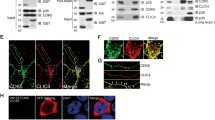Abstract
Cell volume can be altered by two different ways, swelling and shrinkage. Cell swelling is regulated by volume-regulated Cl− channel (VRC). It is not well understood whether shrinkage is regulated by VRC. We previously found that antisense oligonucleotide specific to ClC-3 (ClC-3 antisense) prevented cell proliferation, which was related to cell swell volume regulation. In the present study, we further studied the role of ClC-3 Cl− channel in cell apoptosis which was related to cell shrinkage volume regulation by using antisense oligonucleotide specific to ClC-3 (ClC-3 antisense) and ClC-3 cDNA transfection techniques. We found that thapsigargin (TG), a specific inhibitor of the endoplasmic reticulum calcium ATPase, evoked apoptotic morphological changes (including cytoplasmic blebbing, condensation of nuclear chromatin, and the formation of apoptotic bodies), DNA laddering, and caspase-3 activation in PC12 cells (Pheochromocytoma-derived cell line). TG increased the cell apoptotic population with a decrease in cell viability. These effects were consistent with the decrease in endogenous ClC-3 protein expression, which was also induced by TG. Overexpression of ClC-3 significantly inhibited TG effect on PC12 cell apoptosis, whereas the ClC-3 antisense produced opposite effects and facilitated apoptosis induced by TG. Our data strongly suggest that ClC-3 channel in PC12 cells mediates TG-induced apoptotic process through inhibitory mechanism. Thus, it appears that ClC-3 Cl− channel mediates both cell proliferation and apoptosis through accelerative and inhibitory fashions, respectively.
Similar content being viewed by others
References
Okada Y, Maeno E. Apoptosis cell volume regulation and volume-regulatory chloride channels. Comparative Biochem Physiol 2001; 130(part A): 377–383.
Small DL, Tauskela J, Xia Z. Role for chloride but not potassium channels in apoptosis in primary rat cortical cultures. Neurosci Lett 2002; 334: 95–98.
Wei L, Xiao AY, Jin C, Yang A, Lu ZY, Yu SP. Effects of chloride and potassium channel blockers on apoptotic cell shrinkage and apoptosis in cortical neurons. Pflugers Arch 2004; 448: 325–334.
Szabo I, Lepple-Wienhues A, Kaba KN, Zoratti M, Gulbins E, Lang F. Tyrosine kinase-dependent activation of a chloride channel in CD-95-induced apoptosis in T lymphocytes. Proc Natl Acad Sci USA 1998; 95: 6169–6174.
Porcelli AM, Ghelli A, Zanna C, Valente Ferroni S, Rugolo M. Apoptosis induced by staurosporine in ECV304 cells requires cell shrinkage and upregulation of Cl− conductance. Cell Death Differ 2004; 11: 655–662.
Nietsch HH, Roe MW, Fiekers JF, Moore AL, Lidofsky SD. Activation of potassium and chloride channels by tumor necrosis factor-α. J Bio Chem 2000; 245: 20556–20561.
Shimizu T, Numata T, Okada Y. A role of reactive oxygen species in apoptotic activation of volume-sensitive Cl− channel. Proc Natl Acad Sci USA 2004; 101: 6770–6773.
Lemonnier L, Shuba Y, Crepin A, Roudbaraki M, Slominanny C, Mauroy B, Nilius B, Prevarskaya N, Skryma R. Bcl-2-dependent modulation of swelling-activated Cl− current and ClC-3 expression in human prostate cancer epithelial cells. Cancer Res 2004; 64: 4841–4848.
Duan D, Winter C, Crowley S, Hume JR, Horowitz B. Molecular identification of a volume-regulated chloride channel. Nature 1997; 390: 417–421.
Duan D, Zhong JM, Hermoso M, Satterwhite CM, Rossow CF, Hatton WJ, Yamboliev I, Horowitz B, Hume JR. Functional inhibition of native volume-sensitive outwardly rectifying anion channels in muscle cells and Xenopus laevis Oocytes by anti-ClC-3 antibody. J Physiol 2001; 531: 437–444.
Wang L, Chen L, Jacob TJ. The role of ClC-3 in volume-activated chloride currents and volume regulation in bovine epithelial cells demonstrated by antisense inhibition. J Physiol 2000; 524: 63–75.
Hermoso M, Satterwhite CM, Andrade YN, Hidalgo J, Wilson SM, Horowittz B, Hume JR. ClC-3 is a fundamental molecular component of volume-sensitive outwardly rectifying Cl− channels and volume regulation in HeLa cells and Xenopus laevis Oocytes. J Biol Chem 2002; 277: 40066–40074.
Zhou JG, Ren JL, Qiun QY, He H, Guan YY. Regulation of intracellular Cl− concentration through volume-regulated ClC-3 chloride channels in A10 vascular smooth muscle cells. J Biol Chem 2005; 280: 7301–7308.
Martin TF, Grishanin RN. PC12 cells as a model for studies of regulated secretion in neuronal and endocrine cells. Methods Cell Biol 2003; 71: 267–286.
Maeno E, Ishizaki Y, Kanaseki T, Hazama A, Okada Y. Normotonic cell shrinkage because of disordered volume regulation is an early prerequisite to apoptosis. Proc Natl Acad Sci USA 2000; 97: 9487–9492.
Souktani R, Ghaleh B, Tissier R, Tassigny AA, Aouam K, Bedossa P, Charlemagne D, Samuel J, Henry P, Berdeaux A. Inhibitors of swelling-activated chloride channels increase infarct size and apoptosis in rabbit myocardium. Fund Clin Pharmacol 2003; 17: 555–561.
Do CW, Lu W, Mitchell CH, Civan MM. Inhibition of swelling-activated Cl− current by functional anti-ClC-3 antibody in native bovine non-pigmented ciliary epithelial cells. Invest Ophthalmon Vis Sci 2005; 46: 948–955.
Tassigny AA, Souktani R, Henry P, Ghaleh B, Berdeaux A. Volume-sensitive chloride channels mediate doxorubicin-induced apoptosis through apoptotic volume decrease in cardiomyocytes. Fund Clin Pharmacol 2004; 18: 531–538.
Romero MF, Fulton CM, Boron WF. The SLC4 family of HCO3- transporters. Pflugers Arch 2004; 447: 495–509.
d’Anglemont de Tassigny A, Ghaleh B, Souktani R, Henry P, Berdeaux A. Hypo-osmotic stress inhibits doxorubicin-induced apoptosis via protein kinase A-dependent mechanism in cardiomyocytes. Clin Exp Pharmacol Physiol 2004; 31: 438–443.
Yeung CH, Barfield JP, Cooper TG. The role of anion channels and Ca2+ in addition to K+ channels in the physiological volume regulation of murine spermatozoa. Mol Reprod Dev 2005 (in press).
Wang GL, Wang XR, Lin MJ, He H, Lan XJ, Guan YY. Deficiency in ClC-3 chloride channels prevents rat aortic smooth muscle cell proliferation. Cir Res 2002; 91: e28–e32.
Author information
Authors and Affiliations
Corresponding author
Additional information
These authors contributed equally to this work.
Rights and permissions
About this article
Cite this article
Zhang, HN., Zhou, JG., Qiu, QY. et al. ClC-3 chloride channel prevents apoptosis induced by thapsigargin in PC12 cells. Apoptosis 11, 327–336 (2006). https://doi.org/10.1007/s10495-006-3980-2
Published:
Issue Date:
DOI: https://doi.org/10.1007/s10495-006-3980-2




